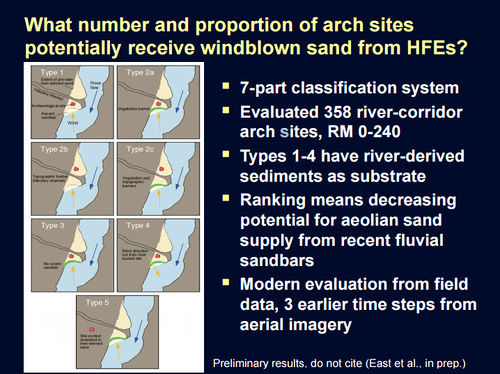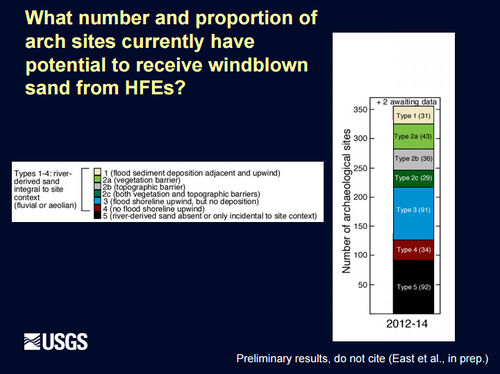Difference between revisions of "Aeolian Sand Transport"
From Glen Canyon Dam AMP
Cellsworth (Talk | contribs) |
Cellsworth (Talk | contribs) |
||
| Line 41: | Line 41: | ||
|style="color:#000;"| | |style="color:#000;"| | ||
| − | + | [[File:AeolianClassification.jpg|center|500px]] [https://www.usbr.gov/uc/rm/amp/twg/mtgs/15jan20/Attach_03.pdf] | |
| − | + | [[File:AeolianCulturalSites.jpg|center|500px]] [https://www.usbr.gov/uc/rm/amp/twg/mtgs/15jan20/Attach_03.pdf] | |
| − | + | ||
| + | Of 358 river-corridor arch sites (RM0-240), 74 (21%) are adjacent and upwind of sandbars receiving HFE sand (Type 1 and Type 2a). 43 of these sites are currently blocked by vegetation from receiving aeolian sand. | ||
|- | |- | ||
| Line 54: | Line 55: | ||
|} | |} | ||
| − | |||
|class="MainPageBG" style="width:45%; border:1px solid #cedff2; background:#f5faff; vertical-align:top;"| | |class="MainPageBG" style="width:45%; border:1px solid #cedff2; background:#f5faff; vertical-align:top;"| | ||
| Line 82: | Line 82: | ||
|style="color:#000;"| | |style="color:#000;"| | ||
| + | '''Collin et al. 2016:''' | ||
| + | *Aeolian deposition was found at 4 sites (30%) where partial infilling occurred preventing further erosion. | ||
| + | *“Despite this promise for archaeological site preservation, our observations show that gully annealing can only occur under a specific set of conditions related to fluvial sand availability and wind transport direction.” | ||
|} | |} | ||
Revision as of 12:10, 23 March 2017
|
|
|
| --- |
--- |
--- |
|---|
|
|

